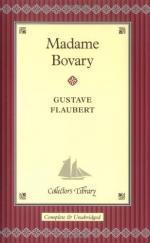So by the advice of the chemist, and after three fresh starts, he had a kind of box made by the carpenter, with the aid of the locksmith, that weighed about eight pounds, and in which iron, wood, sheer-iron, leather, screws, and nuts had not been spared.
But to know which of Hippolyte’s tendons to cut, it was necessary first of all to find out what kind of club-foot he had.
He had a foot forming almost a straight line with the leg, which, however, did not prevent it from being turned in, so that it was an equinus together with something of a varus, or else a slight varus with a strong tendency to equinus. But with this equinus, wide in foot like a horse’s hoof, with rugose skin, dry tendons, and large toes, on which the black nails looked as if made of iron, the clubfoot ran about like a deer from morn till night. He was constantly to be seen on the Place, jumping round the carts, thrusting his limping foot forwards. He seemed even stronger on that leg than the other. By dint of hard service it had acquired, as it were, moral qualities of patience and energy; and when he was given some heavy work, he stood on it in preference to its fellow.
Now, as it was an equinus, it was necessary to cut the tendon of Achilles, and, if need were, the anterior tibial muscle could be seen to afterwards for getting rid of the varus; for the doctor did not dare to risk both operations at once; he was even trembling already for fear of injuring some important region that he did not know.
Neither Ambrose Pare, applying for the first time since Celsus, after an interval of fifteen centuries, a ligature to an artery, nor Dupuytren, about to open an abscess in the brain, nor Gensoul when he first took away the superior maxilla, had hearts that trembled, hands that shook, minds so strained as Monsieur Bovary when he approached Hippolyte, his tenotome between his fingers. And as at hospitals, near by on a table lay a heap of lint, with waxed thread, many bandages—a pyramid of bandages—every bandage to be found at the druggist’s. It was Monsieur Homais who since morning had been organising all these preparations, as much to dazzle the multitude as to keep up his illusions. Charles pierced the skin; a dry crackling was heard. The tendon was cut, the operation over. Hippolyte could not get over his surprise, but bent over Bovary’s hands to cover them with kisses.
“Come, be calm,” said the druggist; “later on you will show your gratitude to your benefactor.”
And he went down to tell the result to five or six inquirers who were waiting in the yard, and who fancied that Hippolyte would reappear walking properly. Then Charles, having buckled his patient into the machine, went home, where Emma, all anxiety, awaited him at the door. She threw herself on his neck; they sat down to table; he ate much, and at dessert he even wanted to take a cup of coffee, a luxury he only permitted himself on Sundays when there was company.




